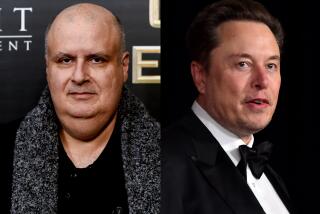Elon Musk shows off a robot that can ‘raise the roof.’ And for now, that’s about all

- Share via
Elon Musk wants autonomous androids to take over humans’ factory jobs.
But on Friday night, the most they could do was gingerly walk across the stage and “raise the roof.”
The Tesla chief executive unveiled his highly anticipated Optimus robot prototype at the company’s annual AI Day, showcasing its efforts in artificial intelligence and robotics. Musk billed it as a recruiting event to bring in talent.
Before the robot made its appearance, Musk warned against high expectations. But he said the latest Optimus iteration would mark a step up from last year’s event, when a dancing human in a skin-tight suit took to the stage dressed as Optimus.
He was right about that. Though it had Hollywood looks (C-3P0 meets the Terminator), the Optimus displayed few functions that haven’t appeared in years past on models from other companies that YouTube viewers have already seen: the robot that looks like a dog, the humanoid that works in the warehouse, the cute Honda robot whose roots go back to the 1980s.
Tesla first showed the Bumble C, a bare-bones prototype with visible wiring that slowly walked to the front of the stage, waved, made a raise-the-roof gesture, then carefully walked back. Musk said it was the first time the robot had operated without a tether. The company showed videos depicting it doing more complicated tasks, such as lifting a box from a shelf and picking up a watering can and watering plants.
The Bumble C was followed by Optimus, version one, which has fewer exposed parts and a silver torso. After it was wheeled to the front of the stage by three Tesla employees, it waved and was pushed to the side. Musk said the robot would be internally tested at Tesla’s auto factory to see “how useful” it is.
“Optimus, I think, has maybe a two order of magnitude potential improvement in economic output,” he said. “It’s not clear what the limit actually is.”
Musk said the Optimus bots would eventually be produced by the millions and would cost less than $20,000 apiece. He added that Optimus’ performance would be more impressive a few weeks from now.
“We want to have really fun versions of Optimus,” Musk said. “Optimus can both be utilitarian and do tasks but can also be kind of like a friend and a buddy and hang out with you.”
But Musk’s promises haven’t always come to pass, on matters ranging from the arrival of full self-driving technology to proposed traffic-solving tunnels. He is notoriously late on deadlines and famously once told an audience at a demonstration that the glass on the Tesla Cybertruck prototype was shatterproof, before it shattered onstage.
Musk first discussed the Tesla Bot at last year’s AI Day, saying the android would be about 5 feet 8, weigh 125 pounds and have a carrying capacity of 45 pounds. Utilizing the same autonomous driving systems as the company’s vehicles, the robots, he claimed, would eventually be capable of such tasks as going to the store to purchase a set list of groceries.
“In the future, physical work will be a choice,” he said at the time. “If you want to do it, you can. But you won’t need to do it.” He offered no timeline.
In some ways, Musk’s view of the future borrows from the sci-fi imaginings of the 1950s: humanoid robots that do one’s bidding, colonies on Mars and high-speed transportation via underground pneumatic tubes. Is this a realistic vision of what could come to pass?
“In some sense, it’s a throwback to what people imagined in the 1950s,” said Martin Ford, a futurist and author of “Rule of the Robots: How Artificial Intelligence Will Transform Everything.” “It could be a vision that comes to pass, though not in the same way he’s presenting it, and not within any immediate time frame.”
It’s not hard to imagine that factories like Tesla’s auto plant could be completely automated at some point in the future, Ford said. It’s just unlikely that they will be staffed with humanoid robots that walk and act like people, instead of specialized robots that are fixed to the ground and designed for a certain task.
Automation is already a large part of car manufacturing, with large industrial robots performing tasks such as putting on doors and lifting. But livestreamed prime-time productions about it are uncommon.
“There’s an emotional appeal to people when you see a robot that looks like a human,” Ford said. “There may be some specific applications. But for the most part, that’s not the case — certainly not in factories.”
Times staff writer Russ Mitchell contributed to this report.
More to Read
Inside the business of entertainment
The Wide Shot brings you news, analysis and insights on everything from streaming wars to production — and what it all means for the future.
You may occasionally receive promotional content from the Los Angeles Times.











